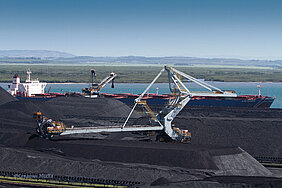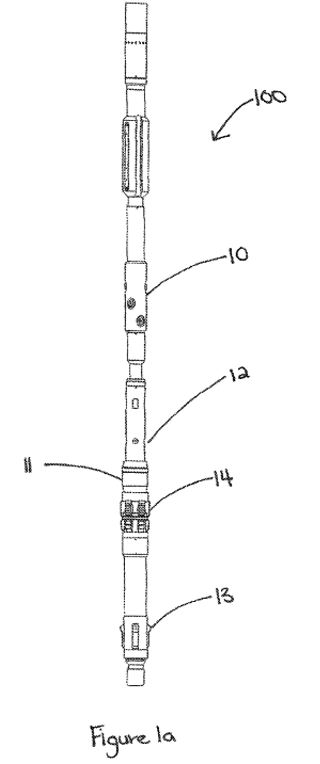Aenert news. Invention analysis
Earlier in our article dated 07.04.2022, we assessed the scale of methane emissions into the atmosphere from the coal industry.
Today, we will consider the latest advancements in coal methane production technologies for its further beneficial use. For this purpose, we have collected more than 10300 patent documents published over the past 20 years to analyze using the Advanced Energy Technologies methodology.
Patents and patent applications have been published in 44 patent offices around the world by 2286 applicants from 38 countries.
Coal seam methane. Cumulative number of patents and applications*, relationship of number of applications to total number of documents by year
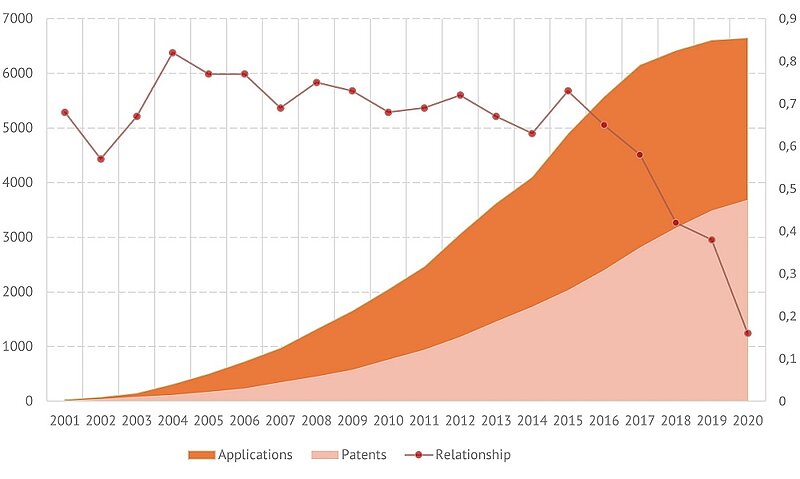
*Areas representing patents and applications are overlapping
The largest numbers of registered patent applications in this field were achieved in 2012-2017, which resulted in a rise in the number of granted patents in 2013-2019. But, in average, the number of patents and patent applications was declining slightly in the last few years. The number of start patent applications, that didn’t belong to previously formed patent families was varying recently, with a peak of 57% achieved in 2019.
A peak in the number of new applicants appearing in the collection of documents related to the subject under consideration was seen in 2012, after which there was a decline in the values with a temporary rise in 2015. The number of new IPC subgroups in the documents was on a rise until it achieved its largest value in 2015. After a spike in 2003, the number of new patent offices was showing a moderate decline throughout the period under consideration. This may indicate a gradual decrease in the interest of the authors in this field of technology, although technological diversity can be evaluated as high in the collection of inventions.
In the collection of documents under revision, the largest number of patents were granted during 20 years in the USPTO (US) patent office – more than 30% of all patents. CNIPA (CN) and IP Australia (AU) were following the leader with almost 22% and 12%, respectively. CIPO (CA), Rospatent (RU), and EPO should also be mentioned as the offices each having a considerable number of patents. In the pool of recent patent applications, CNIPA (CN) was in the lead with about 33%. It was followed by USPTO (US) with more than 20%.
Coal seam methane. Breakdown of inventions by patent offices. Patents, 20 years (left); Applications, 5 years (right)
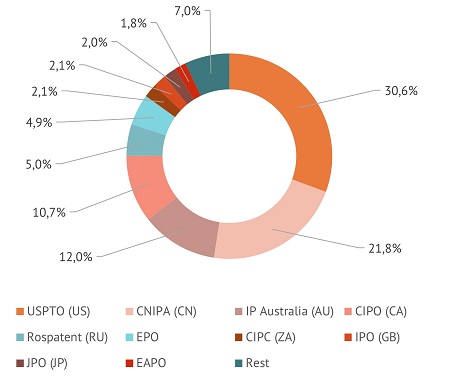
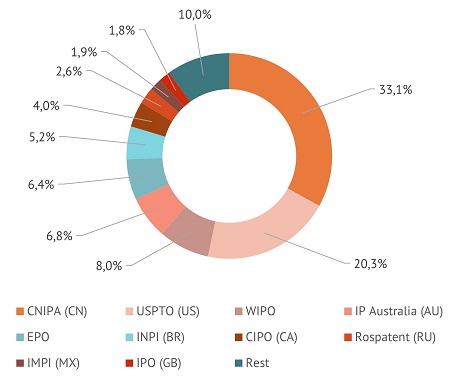
Residents of the USA were in the lead by the number of patents granted during the 20-year period with a share of more than 53% of all cases. In the pool of patents, high activity was also shown by residents of China, the Netherlands, and Canada. In the case of recent patent applications, the first place was taken by the residents of the USA with a share of almost 43%, they were followed by the residents of China and the Netherlands.
Below we provide a list of top 10 applicants with the highest Market involvement ratio for patents published in the 20-year period (Market involvement ratio = volume ratio multiplied by ownership ratio, where Volume ratio - share of applicant documents in total number of documents, Ownership ratio - applicant's participation share in total number of documents):
Coal seam methane. Top applicants by Market involvement ratio. Patents
| Status | Country | Name | Volume ratio, % | Ownership ratio, % | Market involvement ratio, % |
|---|---|---|---|---|---|
| Company | US | ExxonMobil Upstream Research Company | 7.38 | 87.07 | 6.43 |
| Company | NL | Shell Internationale Research Maatschappij B.V. | 7.19 | 100 | 7.19 |
| Company | US | Halliburton Energy Services, Inc. | 5.37 | 93.5 | 5.02 |
| Company | US | CDX Gas LLC | 4.21 | 100 | 4.21 |
| Company | US | Baker Hughes Incorporated | 2.95 | 90.14 | 2.66 |
| Company | US | Shell Oil Company | 2.48 | 82.67 | 2.05 |
| Organization | CN | CUMT China University of Mining and Technology | 2.12 | 95.45 | 2.02 |
| Company | US | Oren Technologies, LLC | 2.04 | 96.62 | 1.97 |
| Company | GB | Johnson Matthey Plc | 1.51 | 93.86 | 1.42 |
| Company | CN | PetroChina Company Limited | 1.51 | 86.82 | 1.31 |
In the collection of patents related to coal seam methane production, the largest number of documents was issued to ExxonMobil Upstream Research Company (US), the company was granted 268 patents. It was followed by four applicants, each of which was granted more than 100 patents: Shell Internationale Research Maatschappij B.V. (NL), Halliburton Energy Services, Inc. (US), CDX Gas LLC (US), and Baker Hughes Incorporated (US). In the collection of recent patent applications, the most active applicants were Halliburton Energy Services, Inc. (US) – 135 applications, CUMT China University of Mining and Technology (CN) – 90 documents, Shell Internationale Research Maatschappij B.V. (NL) – 72, ExxonMobil Upstream Research Company (US) – 70, and Oren Technologies, LLC (US) – 69 applications.
Coal seam methane. Top applicants by Market involvement ratio. Applications
| Status | Country | Name | Volume ratio, % | Ownership ratio, % | Market involvement ratio, % |
|---|---|---|---|---|---|
| Company | US | Halliburton Energy Services, Inc. | 7.79 | 99.63 | 7.76 |
| Organization | CN | CUMT China University of Mining and Technology | 5.2 | 92.89 | 4.83 |
| Company | NL | Shell Internationale Research Maatschappij B.V. | 4.16 | 93.06 | 3.87 |
| Company | US | ExxonMobil Upstream Research Company | 4.04 | 93.55 | 3.78 |
| Company | US | Oren Technologies, LLC | 3.98 | 100 | 3.98 |
| Company | US | Baker Hughes Incorporated | 3.12 | 100 | 3.12 |
| Company | CN | PetroChina Company Limited | 2.54 | 94.7 | 2.41 |
| Company | US | Coiled Tubing Specialties LLC | 2.37 | 100 | 2.37 |
| Company | GB | Johnson Matthey Plc | 2.37 | 100 | 2.37 |
| Company | US | ConocoPhilips Company | 1.85 | 76.88 | 1.42 |
When considering problems, the inventions related to coal seam methane production aim to solve, Low efficiency of production processes comes first in the pool of patents and recent patent applications collected for this analysis. It is followed by Low efficiency of surface treatment and High OPEX / Operation and expendables in terms of popularity. In the vast majority of cases, technical solutions disclosed in the patent documents under revision were represented in the form of methods. Devices were encountered less often, while the number of compositions was even smaller. The most popular IPC subgroups assigned to the patent documents were: E21B43/00 (Methods or apparatus for obtaining oil, gas, water, soluble or meltable materials or a slurry of minerals from wells); E21B43/26 (by forming crevices or fractures); E21F7/00 (Methods or devices for drawing-off gases with or without subsequent use of the gas for any purpose); C10G2/00 (Production of liquid hydrocarbon mixtures of undefined composition from oxides of carbon); and E21B43/267 (reinforcing fractures by propping).
In the collection of documents under consideration, the largest patent families comprise 30, 28, and 27 patent documents and are represented by core documents US20170260854A1, WO2009006693A1, and US7516785B2, respectively (Core document is a base document for which a complete description of the invention is available in generally-accessible patent databases):
HYDRAULIC FRACTURE MONITORING BY LOW-FREQUENCY DAS / A: US20170260854A1 / IPC: E21B49/00, E21B41/00, E21B47/12, G01H9/00, E21B43/26 / JIN Ge, MOSHER Charles C, et al. / CONOCOPHILLIPS COMPANY / Appl. date: 08.03.2017; Publ. date: 14.09.2017 / United States Patent and Trademark Office / Core document: US20170260854A1 / Technology categories: CBM / Technology elements: HF / Problems: HCPP, LEPP / Technical solution types: M / Claims: 16 / Rating: 13
Method and system for production of liquid natural gas / A: WO2009006693A1 / IPC: F25J1/02 / Bridgwood Paul / LNG Technology Pty Ltd, Bridgwood Paul / Appl. date: 07.07.2008; Publ. date: 15.01.2009 / World Intellectual Property Organization / Core document: US20110067439A1 / Technology categories: GEN / Technology elements: MTE, TT / Problems: ESI, HCE, HOOE, LEST / Technical solution types: D, M / Claims: 37 / Rating: 10
Method of developing subsurface freeze zone / P: US7516785B2 / IPC: E21B36/00, E21B43/30, E21B49/08 / Kaminsky Robert D / ExxonMobil Upstream Research Company / Appl. date: 10.10.2007; Publ. date: 14.04.2009 / United States Patent and Trademark Office / Core document: US7516785B2 / Technology categories: CBM / Technology elements: P / Problems: LEPP / Technical solution types: M / Claims: 21 / Rating: 20
The following abbreviations are used in the documents hereinbefore and hereinafter: D - Device; M - Method; C - Composition; CBM - Coal bed methane; GEN - Coal seam methane in general; ESI - Environmental and social impact; HCE - High CAPEX / Equipment; HCG - High costs in General; HCPP - High costs of production processes; HOOE - High OPEX / Operation and expendables; LEPP - Low efficiency of production processes; LEST - Low efficiency of surface treatment; UE - Unaccounted expenses; HF - Hydraulic fracturing; MTE - Methane to electricity; P - Production; TT - Treatment & transportation.
Coal seam methane. Breakdown of documents by family size. Patents and applications

The following are several examples of patents with the highest rating calculated in accordance with the Advanced Energy Technologies methodology in the collection of documents in the field of coal seam methane production:
Coal seam methane. Prominent patent documents by rating:
Treatment fluids comprising diutan and associated methods / P: CA2677462C / IPC: C09K8/68, C09K8/72, E21B43/04, F17D1/17 / Welton Thomas D, Pauls Richard W, et al. / Halliburton Energy Services Inc / Appl. date: 08.02.2008; Publ. date: 31.07.2012 / Canadian Intellectual Property Office / Core document: US7960315B2 / Technology categories: CBM / Technology elements: P / Problems: HOOE, LEPP / Technical solution types: C, M / Claims: 41 / Rating: 23
包含定优胶的处理液及相关方法 (en: Treatment fluids comprising diutan and associated methods) / P: CN101675141B / IPC: C09K8/68, C09K8/72, E21B43/04, F17D1/17 / Welton Thomas D, Pauls Richard W, et al. / Halliburton Energy Services Inc / Appl. date: 08.02.2008; Publ. date: 05.11.2014 / National Intellectual Property Administration / Core document: US7960315B2 / Technology categories: CBM / Technology elements: P / Problems: HOOE, LEPP / Technical solution types: C, M / Claims: 84 / Rating: 23
Assembly and method for multi-zone fracture stimulation of a reservoir using autonomous tubular units / P: US9963955B2 / IPC: E21B29/02, E21B43/1185, E21B43/119, E21B23/00, E21B33/134, E21B43/26, E21B41/00, E21B43/116, E21B47/09 / Tolman Randy C, Entchev Pavlin B, et al. / ExxonMobil Upstream Research Company, Tolman Randy C, Entchev Pavlin B, Angeles Boza Renzo M, Petrie Dennis H, Searles Kevin H, El-Rabaa Abdel Wadood M / Appl. date: 02.03.2016; Publ. date: 08.05.2018 / United States Patent and Trademark Office / Core document: US9284819B2 / Technology categories: CBM / Technology elements: HF / Problems: LEPP, UE / Technical solution types: D, M / Claims: 16 / Rating: 22
Converting organic matter from a subterranean formation into producible hydrocarbons by controlling production operations based on availability of one or more production resources / P: US8540020B2 / IPC: E21B36/04 / Stone Matthew T, Ghurye Ganesh, et al. / Exxonmobil Upstream Research Company, Stone Matthew T, Ghurye Ganesh, Shanley Matthew T, Rasmussen Peter, Huang Xianghui, Kaminsky Robert D / Appl. date: 21.04.2010; Publ. date: 24.09.2013 / United States Patent and Trademark Office / Core document: US8540020B2 / Technology categories: CBM / Technology elements: P / Problems: ESI, HCG / Technical solution types: M / Claims: 40 / Rating: 22
Methods and compositions for the in-situ thermal stimulation of hydrocarbons using peroxide-generating compounds / P: US7185702B2 / IPC: E21B43/25 / Blauch Matthew E, Welton Thomas D, et al. / Halliburton Energy Services Inc / Appl. date: 25.02.2005; Publ. date: 06.03.2007 / United States Patent and Trademark Office / Core document: US7185702B2 / Technology categories: CBM / Technology elements: P / Problems: ESI, LEPP / Technical solution types: C, M / Claims: 20 / Rating: 22
Perforating gun assembly for use in multi-stage stimulation operations / P: US6672405B2 / IPC: E21B17/00, E21B43/117, E21B17/10, E21B43/00, E21B43/11, E21B43/14, E21B43/119 / Tolman Randy C, Kinison David A, et al. / ExxonMobil Upstream Research Company / Appl. date: 18.06.2002; Publ. date: 06.01.2004 / United States Patent and Trademark Office / Core document: US6672405B2 / Technology categories: CBM / Technology elements: P / Problems: HOOE, LEPP / Technical solution types: D / Claims: 50 / Rating: 22
Treatment fluids comprising diutan and associated methods / P: US7960315B2 / IPC: C09K8/58 / Welton Thomas D, Pauls Richard W, et al. / Halliburton Energy Services Inc / Appl. date: 08.02.2007; Publ. date: 14.06.2011 / United States Patent and Trademark Office / Core document: US7960315B2 / Technology categories: CBM / Technology elements: P / Problems: HOOE, LEPP / Technical solution types: C, M / Claims: 29 / Rating: 22
Among the patents and patent applications published over the past 20 years and collected for this analysis, three groups of inventions can be outlined based on the technological aspects they are attributed to. They represent the three less general IPC subgroups of the top list: Methods for stimulating production - by forming crevices or fractures; Methods or devices for drawing-off gases with or without subsequent use of the gas for any purpose; and Specific pattern of wells, e.g. optimizing the spacing of wells. Below are several examples of inventions that concern coal seam methane extraction and have respective IPC subgroups assigned to their documents or to the documents of their patent families:
- US10344561B2 - a ported tubular for use in a casing string with multiple casing joints to permit selective access to an adjacent formation. The tubular housing has lateral flow ports in a section that has a larger inside diameter than the casing joints, while a port closure sleeve slides against the tubular housing to open and close the ports, creating a radially enlarged annular space;
- US10731451B2 - production efficiency is improved by determining the maximum principal stress direction in a low-permeability coalbed, placing large-roadway horizontal wells in the coalbed, each comprising a vertical segment and a horizontal segment (the latter being oriented perpendicular to the stress direction), positioning production wells on both sides of the horizontal segments and fracking the coalbed for methane extraction;
- US10370942B2 - gas extraction from coal seams is improved by a method involving drilling a heat injection borehole using an integrated drilling and slotting drill bit, injecting water to flush the coal seam, adjusting water pressure and turning the drill stem to cut multiple slots, and sealing the resulting borehole. When gas concentration drops below 30%, an orifice is opened in the borehole to inject steam;
- US10858913B2 - a permeability enhancement method by using electric pulse detonation fracturing, comprising building a positive electrode wellbore platform with a high-voltage pulse device and a negative electrode wellbore platform, adjusting the platforms to make close contact with the wellbore walls, discharging the electricity by the high-voltage pulse device for 10-100 cycles. The method is aimed at improving the efficiency of methane production;
- US20220170347A1 - improved coal seam permeability is achieved by drilling multiple boreholes in a single caisson at specific angles to a face cleat and increasing a hydrostatic pressure of drilling fluid using friction or choke methods to increase its weight effect without adding the actual weight.
Methods for stimulating production - by forming crevices or fractures
Patent US10344561B2 published by NCS Multistage Inc (CA) describes a ported tubular for use in a casing string with a number of casing joints to permit selective access to an adjacent formation during completion. The tubular housing has lateral fluid flow ports within a section that has a larger inside diameter than the casing joints. A port closure sleeve is slidable against the tubular housing to open and close the ports, creating a radially enlarged annular space. A locating profile is positioned below the port closure sleeve to engage a shifting tool. The sleeve is a tubular with a constant inside diameter that is not less than the inside diameter of the casing joints. The locating profile can have a profiled surface for engaging a shifting tool or be detectable by a wireline logging tool. The ported tubular may also include a braking mechanism and a shoulder to limit the sleeve's movement within the tubular housing. The invention can be used in fluid treatment operations, for example, with fracturing fluid.
With reference to the prior-art solutions, the authors mention such drawbacks as insufficient reliability of the opening ports and limitations at great depths or in horizontal wells.
The patent is a part of a family comprising 39 patent documents published in CA, US, WO, AU, EP, CN, EA, MX, and UA, between 2011 and 2021.
Image from: US10344561B2
10 - jet perforation device; 11 - compressible sealing member; 12 - equalization valve; 13 - casing collar locator; 14 - mechanical slips; 100 - sand jetting tool.
Patent US10731451B2 by Petrochina Co Ltd (CN) describes an exploitation method for coalbed methane in a low-permeability coalbed. Firstly, the maximum principal stress direction is determined in a coalbed having a permeability lower than a preset value. Next, large-roadway horizontal wells (1-2 m in diameter) are placed through a wall reinforcing technology and a geosteering technology in the coalbed, each comprising a vertical and a horizontal segment. The horizontal segments (more than 600 m in length) are reamed by a high-pressure hydraulic injection, and are oriented perpendicular to the stress direction. The distance between the horizontal segments of adjacent horizontal wells falls within a range of 2-4 km. Multiple production wells are then positioned on both sides of the horizontal segment of each large-roadway horizontal well. The diameter of each production well is smaller than that of the horizontal segments. In this process, the low-permeability coalbed may be fractured to enhance methane extraction. The patented invention also encompasses an exploitation well pattern including the configuration of the large-roadway horizontal wells and the production wells, with the specific dimensions and distances described in the claims.
The authors mention low efficiency of production as one of the prior-art problems.
The patent belongs to a family comprising 7 documents published in 2019 and 2020 in WO, CN, AU, and US.
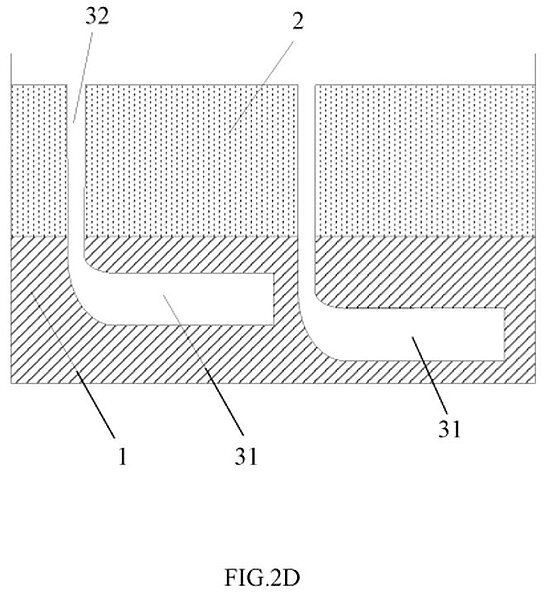
Image from: US10731451B2
1 - low-permeability coalbed; 2 - cover layer; 31 - horizontal segments; 32 - vertical segment.
Methods or devices for drawing-off gases with or without subsequent use of the gas for any purpose
Patent US10370942B2 by China University of Mining and Technology (CN) describes a method for enhancing coal seam gas extraction by integrated drilling, flushing, and slotting. The method involves drilling 3-6 extraction boreholes around a heat injection borehole, sealing the bores for further gas extraction. Drilling the heat injection borehole using an integrated drilling and slotting drill bit through the coal seam floor and the coal seam itself. Injecting water (5 MPa to 10 MPa) while rotating and pulling the drill stem to flush the coal seam and create a drilling and flushing borehole (0.4 m - 0.8 m in diameter). Adjusting water pressure (15 MPa to 25 MPa) and turning the drill stem for 45° to 180° to cut multiple slots parallel to the axial direction of the flushing borehole. The resulting drilling, flushing, and slotting borehole is then sealed. The method further comprises monitoring gas concentration in the gas extraction borehole in real-time and opening an orifice in the drilling, flushing, and slotting borehole when it drops below 30%. Injecting steam (150°C to 450°C) into the borehole for 1-3 hours to increase the concentration. The width of the slots is approximately 0.5 m to 1 m, with a height of around 0.02 m to 0.05 m. The number of slots parallel to the axial direction of the drilling and flushing borehole can range from 2 to 8.
Among the beneficial effects of the invention the authors mention improved gas extraction.
The patent is a part of a family consisting of 7 patent documents published between 2015 and 2019 in CN, WO, AU, and US.

Image from: US10370942B2
1 - heat injection borehole; 2 - gas extraction borehole; 3 - extraction lane on coal seam floor; 4 - coal seam floor; 5 - roof of coal seam; 6 - coal seam; 7 - high-temperature heat-insulating heat supply pipeline; 8 - steam generator; 9 - drilling.
Patent US10858913B2 by China University of Mining and Technology (CN) discloses a permeability enhancement method by using electric pulse detonation fracturing. The method comprises several phases. A positive electrode wellbore and a negative electrode wellbore are built from the ground surface to a coal bed. Using a derrick, a fixed platform with a positive electrode and a high-voltage pulse device is placed in the positive electrode wellbore, while another fixed platform with a negative electrode connected to the high-voltage pulse device is placed in the negative electrode wellbore. The high-voltage pulse device comprises a capacitor and a pulse trigger connected to it, and has a discharge frequency of 5 to 30 Hz and a voltage of 500 to 9000 KV. Using a console, the two fixed platforms are adjusted so that their upper portions make close contact with the wellbore walls, and the two electrodes are contacting the wellbore walls and are arranged face to face on the same level. The high-voltage pulse device is charged by activating a pulse switch. Once a pre-set discharge voltage is reached, the device discharges electricity to the coal bed between the two electrodes. The pulse switch is turned off after 10-100 discharge cycles. The two platforms are removed from their respective wellbores, after which coal bed methane extraction is initiated. The distance between the positive and negative electrode wellbores is specified to be between 150 and 1200 meters.
The authors mention low efficiency as the drawbacks of the prior-art solutions.
The patent is a part of a patent family consisting of 8 documents published in 2017-2020 in CN, WO, AU, RU, and US.
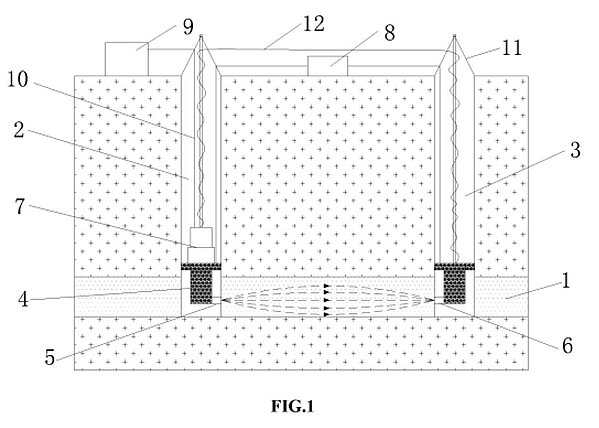
Image from: US10858913B2
1 - coal bed; 2 - positive electrode coalbed methane wellbore; 3 - negative electrode coalbed methane wellbore; 4 - fixed platform; 5 - positive electrode; 6 - negative electrode; 7 - high-voltage pulse device; 8 - console; 9 - high-voltage electric pulse switch; 10 - cable; 11 - derrick; 12 - cable.
Specific pattern of wells, e.g. optimizing the spacing of wells
Patent application US20220170347A1 published on 02.06.2022 by Gardes Robert (US) discloses a method of drilling multiple boreholes in a single caisson for coal bed methane recovery. The method comprises drilling a first production well within the caisson having a first lateral well at least parallel or at 45 degrees angle to a face cleat. Drilling a second lateral well from the first lateral well perpendicular to a face cleat. Circulating drilling fluid (substantially clear water) with a hydrostatic pressure less than that of coal bed formation. Increasing the hydrostatic pressure of the circulating drilling fluid using friction or choke methods to increase its weight effect from about 8.6 lbs/gal to at least 12.5 lbs/gal, without adding the actual weight, and prevent collapse of the formation during drilling. Drilling a second production well within the caisson, with a third lateral well parallel to a face cleat and a fourth lateral well perpendicular to a face cleat. The two production wells are used to recover gas from produced water. The produced fluid is filtered and separated to remove solids, and returned beneath a surface of the coal bed formation via an injection well in the same caisson. The recovered gas is stored above the surface.
According to the authors, in prior-art solutions chemicals are added to increase a specific gravity of drilling fluid. The chemicals are absorbed by coal, which reduces the permeability of the coal seam by as much as 85%. The invention solves this problem by eliminating a need to add weighting agents and chemicals.
The application belongs to a patent family comprising 9 documents published in the CA and US patent offices between 2014 and 2022.
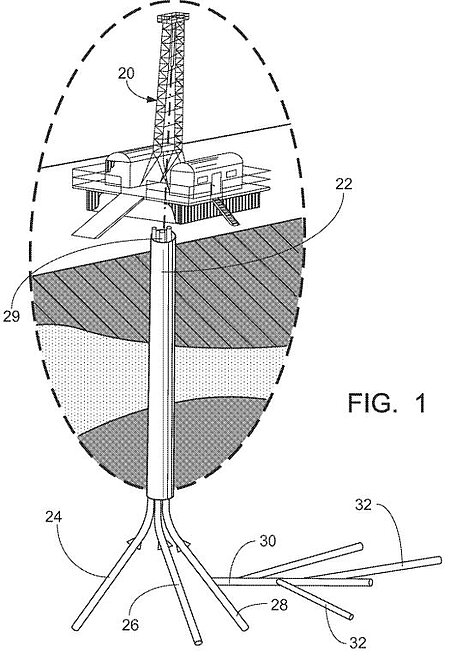
Image from: US20220170347A1
20 - drilling rig; 22 - single caisson; 24,26,28 - wells; 29 - vertical well section; 30 - horizontal well; 32 - lateral wells.
In the analysis of inventions from the present collection of documents, it was uncovered that, besides coal seam methane production technologies, the inventors tend to focus their attention on three different aspects of the industry. These aspects include involvement of hydraulic fracturing in coal seam methane production, technologies of liquid fuel production integrated in or subsequent to methane production steps, and specific methods and equipment for coalbed drilling. Treatment and transportation of the produced methane, and exploration of coal seam reserves are other aspects of the industry widely represented in the revised collection of documents.
More detailed information about inventions in the field of coal seam methane extraction, and patent research methodology can be found on aenert.com, and in the respective database.
By the Editorial Board
